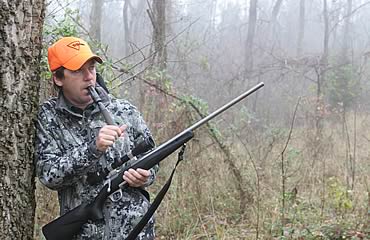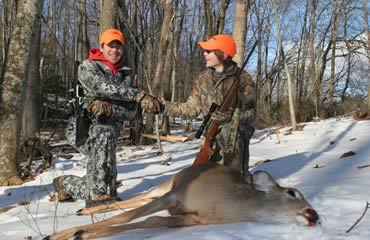It’s not that difficult to pull in bucks by rattling and grunting.
When daylight broke on a cold Iowa morning two years ago, Rick White knew exactly what to do. It was the pre-rut in early November, so just a few minutes after he settled into his stand, the 47-year-old Cedar Rapids resident pulled a rattle bag out of his backpack and started grinding it between his hands.
The woods were quiet, perfect for calling, and just a few minutes after his first calling sequence, the silence was broken by the crunch of leaves. Not one, but two small bucks trotted in. After they left, White resumed rattling, and yet another buck walked under his stand. And then another.
A while later, a fifth buck came in for a look. When the morning was over, White had pulled in a dozen different bucks, including one that fell just short of his personal goal for loosing an arrow.
“It was the best morning of calling I’ve ever experienced,” he remembers.
It’s not always that easy, says White, a full-time Hunters Specialties pro-staffer. He went back the next morning under identical conditions but failed to draw in even a single buck. That’s the way it is with deer calling.
White admits he has the luxury of hunting some prime land that doesn’t get much pressure. That’s one reason he calls in so many deer, but that’s not the only reason. He rattles, grunts and bleats in so many whitetails because he’s done it enough to understand when it will work and when it won’t. Most of all, he knows that he can’t pull bucks into bow or gun range if he doesn’t call.
“I’ve gone through plenty of periods when it didn’t work, but it does work, so you can be sure I’m going to at least give it a try,” he says. “It’s worked in just about every state I’ve tried it.”
BANGIN’ HEADS
White doesn’t always carry a rattle bag or a set of antlers, but he will when the rut is in full swing or anytime the bucks are thinking about searching for willing does. In fact, he says the two weeks leading up to the rut is the best time to bang antlers together. That’s when bucks are sparring for dominance, and the sound of two bucks bashing heads can bring in a big deer.
Others respond out of curiosity — they want to see who’s fighting — or an innate hope that a hot doe is near the fighting bucks. If a pair of bucks is fighting, explains White, they might be fighting over a doe in estrus while another buck will sneak in to steal the female.
 Why those bucks are fighting doesn’t matter much when White starts a rattling sequence. His methods are all the same. He starts out by rattling for 10 seconds or so, but he does it somewhat softly in case a buck is close. He simply rattles, puts down his bag and picks up his bow or gun and gets ready. White says the biggest mistake you can make is to assume rattling won’t work.
Why those bucks are fighting doesn’t matter much when White starts a rattling sequence. His methods are all the same. He starts out by rattling for 10 seconds or so, but he does it somewhat softly in case a buck is close. He simply rattles, puts down his bag and picks up his bow or gun and gets ready. White says the biggest mistake you can make is to assume rattling won’t work.
“Pick up your gun and be ready,” he says. “I’ve had deer come running in before I even finished a sequence, and I’ve seen them come sneaking in after five or 10 minutes.”
If no bucks show up after about 10 minutes, White increases the volume and intensity, and rattle a little longer. He might rattle two or three times before stopping, or he might rattle aggressively for 20 or 30 seconds.
If it still hasn’t worked, White doesn’t get discouraged. He’ll use his rattle bag throughout the day, picking it up every 15 to 20 minutes.
“Sometimes bucks lock horns and really go at it for a long time; sometimes they just push on each other for a few seconds, part and then go back to it. It can be real loud and violent, or it can be pretty soft,” he says. “There is no right or wrong way to rattle.”
GRUNT THEM IN
What is wrong, or at least what might cost you a deer, is not incorporating a few grunts in a rattling sequence. Just as he carries a rattle bag or antlers during the pre-rut and rut, White also keeps a grunt tube around his neck. Deer don’t always come to the sound of two bucks fighting, but they might approach when they hear a grunt. After White puts down his rattle bag, he’ll blow a few notes on his grunt tube, or he might rattle, grunt and then rattle some more. Again, it’s hard to do anything wrong.
He doesn’t just use a grunt tube during rattling, however. He always carries one in the deer woods no matter what the conditions or time of year. A grunt tube is such an important part of his hunt that White will walk back to get one if he leaves it in his truck, even if it means burning a few prime minutes. He’s pulled in bucks and does throughout the entire hunting season and at all times of the day.
“There is no bad time to use a grunt tube,” says White. “They work early in the season and late.”
 Experience taught him that it’s virtually impossible to spook a deer by blowing on a grunt tube. He’s watched countless deer while hitting a few notes, and he’s even attempted to over-call just to see how deer react.
Experience taught him that it’s virtually impossible to spook a deer by blowing on a grunt tube. He’s watched countless deer while hitting a few notes, and he’s even attempted to over-call just to see how deer react.
“If they aren’t interested, they won’t so much as look up, so I’m not worried about calling at the wrong time or calling too loudly or too softly. It’s real hard to mess up,” he says.
White uses a simple sequence of a few one- to two-second grunts every 10 or 15 minutes. Sometimes, he’ll grunt a little more, sometimes a little less. Experience has taught him that there is no wrong or right way to blow a grunt tube, unless, of course, the notes are sour or too loud. He doesn’t worry about specific deer vocalizations like tending grunts or challenge grunts. White simply blows a few quick notes, waits and repeats.
STILL NOT WORKING?
The bad news, of course, is that bucks don’t always come running to the sound of two deer fighting or a few grunts.
And bucks and does can be conditioned to avoid the sound. That happens more often on pressured land, or when a deer has busted a hunter who is using a call. Sometimes it’s impossible to avoid deer circling downwind, but some common mistakes can be avoided.
“Never rattle or grunt when a deer is looking in your direction, especially if he’s close,” he says. “The last thing you want to do is have that deer lock on to you and associate danger with the sound of rattling or grunting.”
As White noted earlier, bucks come running to rattling antlers for a couple of reasons: They want to investigate a fight, they want to fight the deer already butting heads, or they want to steal a hot doe. In many areas, however, they simply don’t have to work for a doe because there are far more does than bucks, so they’ll avoid a fight.
“I’ve actually seen smaller bucks turn and walk away because they didn’t want to get beat up by a bigger buck,” he said. “I’ve also tried to rattle and grunt mature bucks away from a hot doe, but they aren’t going to leave a doe that’s ready to breed.”
Another reason calling doesn’t always work is there might not be a buck within hearing distance. That’s why it’s important to continue to call throughout the morning, especially during the rut when bucks are on the move. And even then, they might not be interested.
There’s no telling what goes through a whitetail’s brain when it hears rattling or grunting, but, as White has observed, they all don’t drop everything and trot in to investigate the other “deer” they hear, not even during the rut.
But some do.
That’s why it pays to at least try rattling and grunting, even if it hasn’t worked for you yet. Try it on the right day, and who knows? You might just pull in a dozen bucks.
Read Recent Articles:
• Brown Velvet: Looking for the perfect something to hang next to that Elvis painting?
• Bow Bucks in the Deep Freeze: Cold-weather bowhunting requires extra practice.
• Right Time, Right Buck: Weather and an empty stomach get the best of this old warrior.
This article was published in the July 2010 edition of Buckmasters Whitetail Magazine. Subscribe today to have Buckmasters delivered to your home.